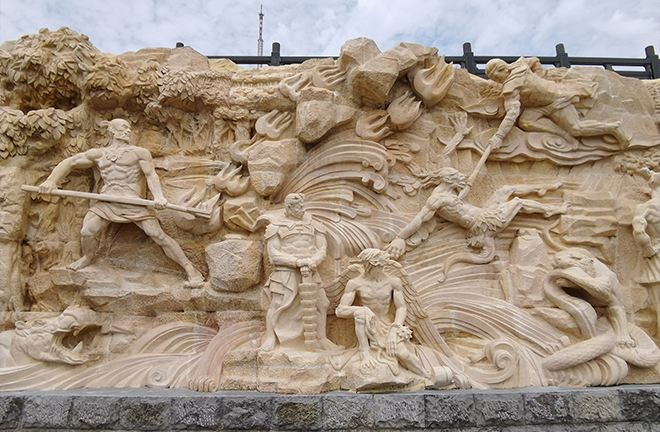Disaster mythology represents traditional ecological wisdom

A relief sculpture depicting “Great Yu Controls the Waters,” one of ancient China’s most famous disaster myths, in the Great Yu Mythological Park, Wuhan, Hubei Province. Photo: IC PHOTO
Mythology is a narrative form through which humanity has long sought to interpret the world, trace its origins, and explain cultural creation. It also represents a body of localized traditional knowledge, developed over centuries as communities adapted to nature while striving for self-governance. Disaster mythology—a ancient subgenre—focuses on the causes of disasters, strategies for prevention and mitigation, and post-disaster recovery. In China, research on disaster mythology remains relatively fragmented, with most studies emphasizing the narratives themselves. Scholars would benefit from adopting a more comprehensive approach that includes analysis of narrative structures and cultural functions.
Transmission through multiple narrative modes
Disasters have accompanied human history from its earliest stages. Disaster mythology encompasses a broad spectrum of natural threats—including climatic, geological, oceanic, and biological disasters such as droughts, floods, fires, earthquakes, landslides, dust storms, snowstorms, tsunamis, plagues of pests, and epidemics. These events have long posed serious, even catastrophic, challenges to human society. Disaster mythology thus emerges as a form of cultural adaptation—rooted in humanity’s efforts to understand, mitigate, and survive disaster in pursuit of sustainable development.
These myths are transmitted through multiple narrative modes: oral storytelling, written texts, ritual performances, and spatial representations within the natural and built environment. In prehistoric times, myths were passed down orally. With the advent and spread of writing systems, these stories gained permanence and could be transmitted across time and space. Myth and ritual are often interwoven, with ritual acting as a performative narrative. Disaster myths are also inscribed into both natural and cultural landscapes, which serve as sites of mythological memory or cultural markers of disaster response and resilience.
Providing ecological insights
Disaster mythology holds distinctive ecological value, particularly in its capacity to transmit disaster memory, critique unsustainable practices, and affirm collective resilience. First, it preserves and activates historical memory of disasters, passing down early conceptions, experiences, techniques, and institutional practices for disaster prevention. These narratives provide not only practical knowledge but also the psychological strength and moral courage to confront adversity. Second, many disaster myths contain ecological critiques—warning against environmental mismanagement or social disorder. These stories emphasize the importance of ecological balance and ethical conduct. Third, humanity’s struggle against nature, portrayed in disaster mythology, vividly demonstrates their resilience, agency, and indomitable spirit—even when facing harsh environments and catastrophes.
Addressing modern challenges
For local communities, these myths, as practical traditional knowledge, are not merely tales of fear and awe—they are sacred narratives featuring deities and ancestors, evoking a sense of authenticity. This localized ecological knowledge also holds practical relevance, as it originates in everyday life and rejects abstract theoretical preaching. It fosters ecological awareness among locals, regulates their behavior, and ultimately contributes to the sustainable development of local societies.
China is home to a vast and varied corpus of disaster mythology, scattered across the diverse cultural carriers of various ethnic groups. Yet only a fraction of these resources has been collected and studied, and most existing research remains limited to textual analysis and historical tracing. To realize the full potential of this heritage, interdisciplinary collaboration is essential. Scholars in mythology, folklore, and anthropology should form interdisciplinary research teams to conduct comprehensive, in-depth fieldwork from a holistic perspective, utilizing advanced digital tools document, translate, and organize materials, with the goal of building a national database of Chinese disaster mythology.
Comparative analysis of disaster myths from different regions and ethnic groups will facilitate the production and transformation of ecological knowledge in three ways: as a humanistic complement to disaster prevention and mitigation technologies, as a unique resource for cultural tourism and creative industries, and, through systematization, as a foundation for sustainable traditional ecological culture. Academically, expanding research on disaster mythology will drive the development of mythology as a discipline.
In an era marked by environmental degradation and increasingly frequent natural disasters, the academic community should extensively explore how disaster mythology can be reconstructed, transformed, and applied. These narratives can offer traditional ecological wisdom that not only informs practical action but also embodies enduring humanistic values. This will activate collective disaster memory, boost confidence and courage in addressing ecological crises, and encourage a shift away from anthropocentric ecological views and practices.
Huang Longguang is a senior editor at the Journal of Yunnan Normal University.
